Wednesday September 17 and Thursday September 18, 2014
Mammoth Cave National Park Campground
Mammoth Cave, Kentucky
WEDNESDAY
We drive 339 miles. We finish out Kansas and drive almost completely through Missouri. We stop just before we get to St. Louis. Unfortunately that means tomorrow we will have to drive through during morning rush hour. SIGH………. I so hate driving in/around big cities. But the interstate is the fastest way from point A to B in this case and we need to make tracks.
We are parked in the Cracker Barrel Parking lot in St. Charles Missouri. They have pull through parking sites they want you to park in but no one towing would fit. So we park in back by the dumpster and it is blessedly quiet. No dual interstates or trains like last night in a you pay for it campground. Of course we did spend the cost of the campground having dinner at Cracker Barrel. Next time we do it, I think we will have breakfast in the morning instead. But tonight, after 339 miles neither of us felt like cooking anything or even warming up some leftovers.
Tomorrow is 311 more miles to make it to Mammoth Cave.
THURSDAY
We’re out just after sunrise but not in time to beat the rush hour around St. Louis. I just grit my teeth. I get a quick picture of the arch out the screened in passenger window. I sure wish I could easily take the screen out. It would make picture taking on the road so much. As we finally get around St. Louis on the interstate I breathe a sigh of relief and wonder what we might have seen in Missouri had we been taking our regular leisurely pace. Not St. Louis probably but I know there are natural areas here that we would love.
We drive through the rest of Missouri, through Illinois, Indiana and Kentucky. Such a haul ass trip over two days is unheard of for us and I hope we never hear of it again. We cross the Missouri River, The Mississippi River, the Wabash River, the Ohio River and the Green River.
In Kentucky we take the Lloyd Expressway. I wonder if it is named after some Welshman related to me. My maiden name is Lloyd. For fun, we called ourselves the Lloyd Boyds for a while but thought that was too much for Carrie.
We arrive at quiet lovely Mammoth Cave National Park around 2:30 and take Ruby off the dolly to check out the campsites. The very nice woman at the gate recommends site 82 and after going all around we agree. There are no hookups but we have a great pull through right by the restrooms. Only problem is almost no sun but enough we hope to get us through 5 days.. Everything is heavily wooded. $42.50 for 5 nights with our fabulous senior pass. Boy the price is right.
We level up, put out the slides and head out to get the last tour of the day, the 3:30 ninety minute Mammoth Passage Cave Tour. We purchase our tickets at the visitor center, $2.50 each with our old folks pass. I really didn’t expect the tours to be half off too. Be sure to bring it with you though, they check.
Our tour leader is Jackie Wheet. He’s a life long local resident with a wonderful KINtucky twang. We meet him under one of the shelters next to the visitor center where he briefs us on some of the rules: no strollers, no backpacks, no tripods, no child backpack carriers. He also provides some introductory information.
Mammoth Cave is the world's longest known cave, with more than 400 miles of interconnected passages—so long that if the second and third longest caves in the world were joined together, Mammoth Cave would still be the planet's longest cave and have more than 100 miles left over!
The cave is still being explored. Twelve miles of passageways are open for touring on one of the many and varied tours offered by the park
The cave is down a wide walk from the visitor’s center which you can see in the top right of the picture of the entrance below. When we round the corner we can feel the cool fresh crisp air. Hot surface air expands becoming less dense which lets cooler denser cave air pour out through the lower cave entrances. This creates a partial vacuum in the cave. Fresh air is drawn down through higher entrances to replace the exiting air. Deep cave temperatures remain between 55 and 57 degrees year round.
This tour begins at the original entrance now called the historic entrance. I came here as a child with my parents in the late 50’s, one of very few vacations we took. We brought Carrie and her friend Kate here in 1991. So this park has lots of memories for us.
I love the historic entrance. Other than the ramps, it looks just like a cave entrance should look. Many of the tours begin here so I’m sure we will see it several times during our stay. We are taking LOTS of tours.
Thanks to the National Park Service for this picture of the original entrance before development. I just can’t imagine finding it for the first time. How thrilling!
Archeology has shown that Native Americans discovered Mammoth Cave about 4,000 years ago and continued to use it for 2,000 years. After that there is no evidence of use until the late 1700s.
Local legend has it that, in the late 1790’s a young boy chased a wounded black bear in this entrance, rediscovering the cave and all its secrets. People have been touring the cave since just after the war of 1812. For years the guides were African American slaves. Prior to the creation of the park, people coming to tour the cave out here in the middle of nowhere would have to be people of means. The group would have its picture taken. This one is from 1910. The tour was by grease-oil lantern light
Pretty different from 1991 when the 11 year old Carrie and her 10 year old friend Kate crawled around with headlamps on.
We go down into the cave and through the bat protection entrance which I’ll talk about at the end. The lighting is very dim, enough for safety, barely enough for cameras. No flash allowed.
We walk deeper into the cave and find a large area of wooden structures which have been left from the early 1800’s. The earth of the floor of the cave was rich in nitrates of calcium and potash. By leaching processes this “saltpetre” was made available. During the war of 1812 slaves mined the saltpeter from the cave sediments to be used in the manufacture of gunpowder. This was the seriously backbreaking work of digging up the cave floor and “rinsing” the dirt. The vats and wooden pipes made from hollowed out poplar trees that we see are not reproduction facilities. These are the originals still here and being preserved in the cave.
The mining operations continue all along the path to and into the Rotunda, one of the largest rooms in the cave and possibly the reason it was named Mammoth. You have to be there to get the sense of how big it is. Jackie is standing to the right in front of the continuing poplar pipes that seem to go on forever. He is talking about this room being used for church services.
The rest of the passageways were just too dark to photograph but I did get a picture of one of the “signatures” which are in many places in the cave. This is now considered defacing the cave and is a federal offense. But in the 1800’s the slave guides made many tips on helping or doing the signatures and initials of tourists.
The picture below, taken on our way back, from a higher vantage point, gives a better idea of the size of the rotunda.
After what may have been the fastest 90 minutes I have spent, we are approaching the bat doors at the exit. Well not doors exactly.
The cave has a metal door at a right angle and connected to this first section of bars. It is locked to keep out vandals. But the sides are bars to allow the bats free access.
Mammoth Cave has 9 species of bats. They seldom hang out in the lighted areas so seeing them is not common.
Two species of bats found here, the Indiana Bat and the Gray Bat are on the endangered species list.
Mammoth Cave was once one of the largest bat hibernation caves in the world. There were millions of bats on 150 years ago but their numbers have been diminished by human disturbance.
Unfortunately in January of 2013 a northern long eared bat was found to have white nose syndrome. The bat was found in Long Cave, an undeveloped cave 1.3 miles long, which is the park's largest bat hibernaculum and houses endangered Indiana bats and gray bats, along with other non-threatened species. Long Cave has not been open to visitors for more than 80 years.
White-nose syndrome is known to be transmitted primarily from bat to bat, but spores of the fungus that causes white-nose syndrome, may be inadvertently carried between caves by humans on clothing, footwear, and caving gear. White-nose syndrome is not known to affect people, pets, or livestock but is harmful or lethal to hibernating bats, killing 90 percent or more of some species of bats in caves where the fungus has lasted for a year or longer, according to the U.S. Fish and Wildlife Service.
Bats play a key role in the food chain.In caves, for example, bat guano is a food source for animals that spend their entire lives underground.In forests and farm fields, bats play an important role by consuming enormous numbers of damaging insects such as beetles and moths.They also eat mosquitoes and without them many of us will have much less opportunity to happily be outdoors in swampy environments. The number of North American bats estimated to have died from white-nose syndrome thus far had the capacity to consume up to 8,000 tons of insects per year according to the United States Geological Survey.
The last thing we do before leaving the cave area is to walk across decontamination mats to hopefully kill any white nose syndrome spores that we might take on to our next destination. I love caves and bats so I am very happy to see these mats.
On our walk back up to the visitor center we stop at the interpretive signs and read about some things not mentioned on our tour. One sign though is very familiar to us. It seems that everywhere we have been this summer the natural history of the place includes that it was once under a shallow sea.
Here, in the Pennsylvania period , 280 million years ago (those numbers are just hard to even imagine), a layer of sand and silt was laid down by the ancient Michigan River delta, forming the slanted layers of mixed sandstone and shale visible right across from the information sign (picture below).
It’s a caprock and beneath it lie 600 feet of layered limestone deposited as an ancient sea bed some 350 million years ago. The miles of cave passages that make up Mammoth Cave are found within these layers. Sandstone and shale are more resistant to being dissolved by water than is the limestone beneath. This caprock of sandstone and shale acts like a roof, shedding water to the side of the ridge. This is the same caprock story we heard in Utah at Capitol Reef and Arches. We heard it again in Colorado at Black Canyon, caprock protecting the limestone from eroding. And yet these places look nothing like each other. What an amazing planet.









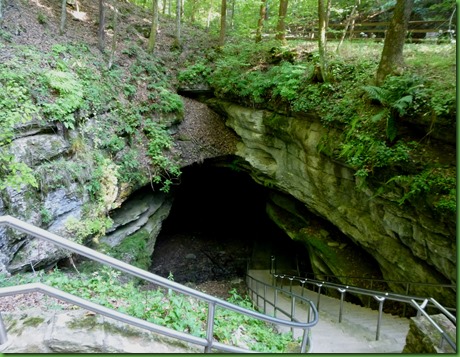




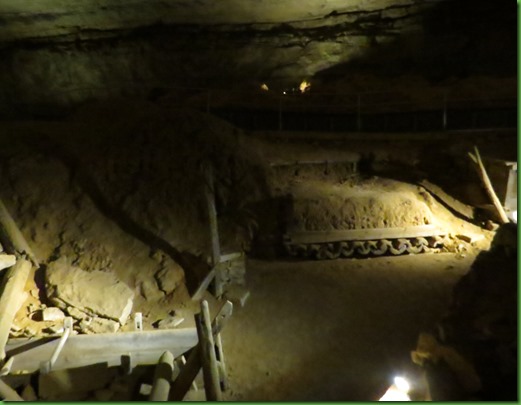
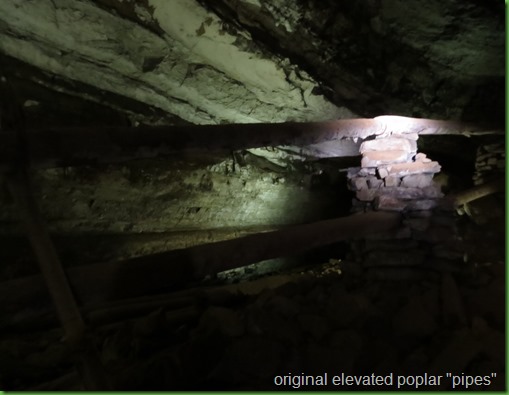



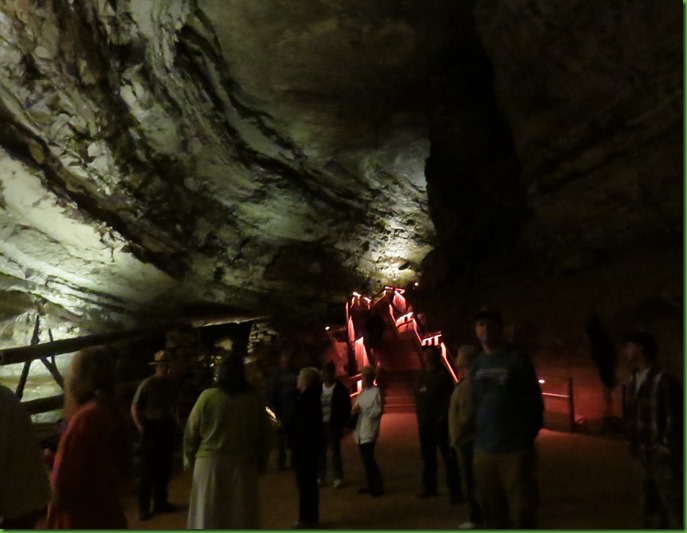



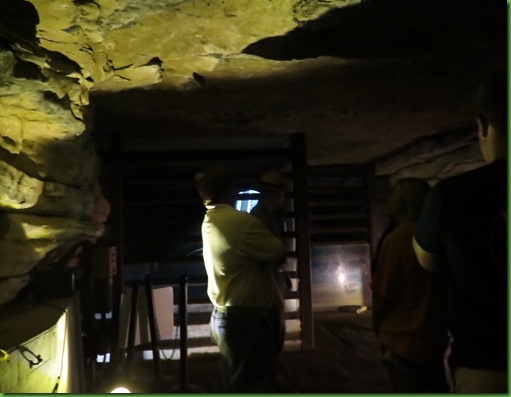

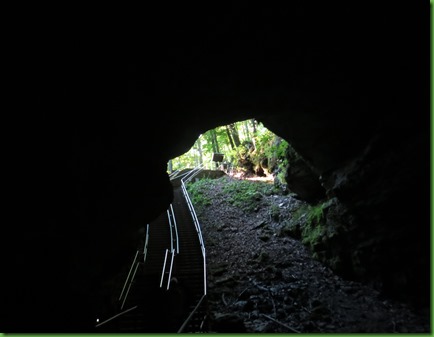




Great cave tour! Mammoth Cave was one of our first RV trips with our kids over 20 years ago:)
ReplyDeleteWhat a beautiful picture of your daughter and her friend. . .treasured memory!
ReplyDeleteI plan to never go in another cavern (other than Carlsbad) but we do love the Mammoth Cave area. . .so beautiful. . .
Loved the information you provided of the caverns. Been there several times, but glad to be able to tour once more through your blog.
ReplyDeleteWow! As much as I love to cave have never been to Mammoth. Yet another place you've given me to add to the list.
ReplyDeleteLoved Mammoth Cave. We did the "Wild Cave Tour" there a few years back, definitely on our list of amazing things we've seen and done!
ReplyDeletewww.travelwithkevinandruth.com
Sounds like a wonderful informative tour. Are any parts of this cave system alive? Or was the cave mainly for mining? Thanks for so many interesting facts:)
ReplyDeleteAmazing cave! That was a great trip we took in 1990! So interestimg about bats and how important they are! Also interesting is the history of people and geology. How did the shallow sea turn into so many different regions!?
ReplyDeleteCool cave- another place we need to put on our list. I am glad they have the mats too! I love bats- such good creatures.
ReplyDeleteA long drive and then you still had energy to get out and go on a tour. I'm impressed.
ReplyDeleteI heard about the white nose syndrome and its impact on the bat population for the first time when we toured a cave in VA ... another example of how a shift in nature's balance has a ripple effect.
If those walls could talk........such a variety of "lives" the cave has had. I love that there are still un-explored areas - places where modern man has not tread :-) Bats were part of my growing up in the desert, and it's sad to know so many have been wiped out by a single disease. The tilted layer of rock under the tree in that last photo is fascinating!
ReplyDeleteMy husband & I took our kids to Mammoth Cave several times during the 1970's. We all loved it, and after seeing other caves in the U.S., Mammoth is the only one I'd like to go back to.
ReplyDeleteI'm fascinated by Mammoth. I passed through the area with family as a child, but we didn't stop there. Beautiful shots inside!
ReplyDeleteMy first trip to Mammoth Cave was in the early 50's. My family stayed in one of the little cabins in the park.
ReplyDeleteWe also enjoyed our tour at Mammoth Cave but skip the historical tour that you took. It was summer and it was a little crowded so opted for the lesser popular tour. Now I see what we missed and I learned more. Steve is always fascinated by caves and we heard first of White Nose Syndrome when we visited our first cave at the Oregon Caves National Monument.
ReplyDeleteI'm always happy to see bats, knowing what a great job they do eating mosquitoes! I'm glad there are efforts being made to protect them from the spread of white nose syndrome (we encountered a similar decontamination procedure at Lehman Caves in Great Basin NP), but I hope there's more that can be done. Adorable photo of Carrie!
ReplyDeleteMammoth Cave has been on my list for years, I think it might be even better if I visit it with the grandsons, they'd get a kick out of it.
ReplyDeleteBTW, Congrats on surviving two PDD driving days in a row! (Bronze Level) :cD
Mammoth Cave was our first National Park stop back on our first full-timing adventure. We bought our first national park pass there, but it was the height of tourist season and too crowded to enjoy touring. We really need to get back there. In the mean time, we will enjoy touring with you;o))
ReplyDeletePaul is only being kind about your two PDD days....339 miles is something he could do by lunch. :)
ReplyDeleteI have heard about the white nose syndrome and it's such a shame. I hope they will be able to recover.
That's a wonderful place to visit. I seem to remember Kevin and Ruth going into a cave where they had to crawl through openings. I'm wondering if this it the same place. I guess I'll have to check back and see what other tours you find.
I really enjoy watching the bats come out right at dusk. They flit around eating all those bugs! Nice pictures too.
ReplyDeleteLove parks with bats as they are usually less buggy but we keep swinging right past this one as we go back and forth. I'm thinking spring because the forest there is probably loaded with wild flowers and not many folks bothering to hike! What cute pic of the girls!
ReplyDeleteLove Mammoth Cave. It is the only cave I have seen where the passages are large enough to drive a car through them! Great history too to see how far back in the cave the native Americans were able to go over 2000 years ago using torches.
ReplyDelete